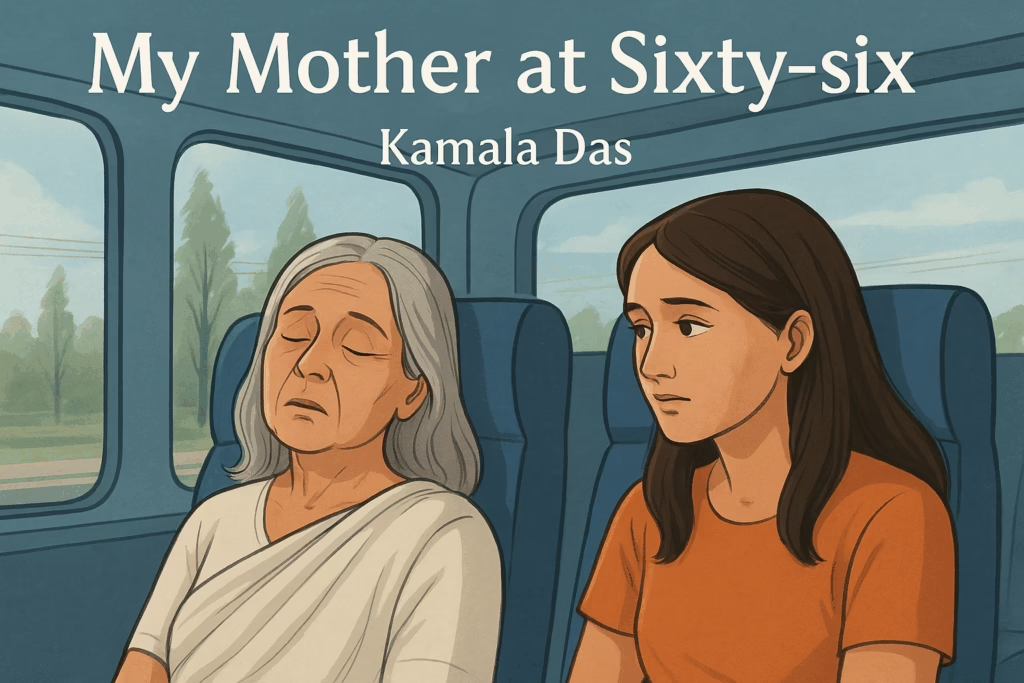Summary of “My Mother at Sixty-six”
“My Mother at Sixty-six” is a deeply emotional poem in which Kamala Das expresses her fear of losing her ageing mother. While driving to the Cochin airport, the poet notices her mother dozing in the seat beside her, her face pale and lifeless like a corpse. The sight fills the poet with pain as she realises the harsh reality of her mother’s old age.
To distract herself, she looks outside at the young, sprinting trees and the happy children running out of their homes—images that symbolise life, energy, and youth, sharply contrasting her mother’s frailty.
After the security check at the airport, the poet glances at her mother again and finds her looking wan and pale like a late winter’s moon. This brings back the poet’s childhood fear of separation. Despite this deep emotional turmoil, she chooses not to express her sorrow. Instead, she smiles repeatedly and tells her mother, “See you soon, Amma,” hoping to reassure both her mother and herself.
The poem beautifully conveys the universal emotion of love mixed with the anxiety of losing a parent, highlighting the inevitable cycle of life and death.
Introduction About the Poet – Kamala Das
Kamala Das (1934–2009), born in Malabar, Kerala, is widely regarded as one of the most powerful and original voices in modern Indian English poetry. Known for her boldness, emotional honesty, and confessional style, she wrote with rare sensitivity about the inner world of women, the complexities of love, desire, ageing, and the delicate threads of human relationships.
A versatile writer, Kamala Das produced an impressive body of work in both English and Malayalam, writing her Malayalam fiction under the pen name Madhavikutty. Her literary career includes novels, short stories, autobiographical writings, and five important collections of poetry, all of which display her intimate, lyrical voice and her ability to turn personal experiences into universal expressions of emotion.
What makes Kamala Das stand apart is her fearless portrayal of reality—whether it is the pain of unfulfilled love, the struggle for emotional freedom, or the silent suffering of women in society. Her language is simple yet intensely poetic, making her poems both accessible and deeply moving.
Her poem “My Mother at Sixty-six”, included in your text, is a beautiful example of her sensitivity. Here, she captures the tender, painful moment of recognising her mother’s ageing and the timeless fear of losing a loved one. Through vivid imagery and heartfelt expression, Kamala Das transforms an everyday experience into a powerful reflection on life, love, and mortality.

Textual Questions and Answers
Answers to All Questions
1. What is the kind of pain and ache that the poet feels?
The poet feels the emotional pain of realising her mother’s old age. Seeing her mother’s ashen, corpse-like, pale face reminds her of the fear of losing her mother, a fear she has carried since childhood. This pain is a deep, intimate, and universal fear of separation from a loved one.
2. Why are the young trees described as ‘sprinting’?
The “young trees” appear to be sprinting because, from the moving car, the trees seem to run backward very fast. Symbolically, their energetic movement contrasts with the stillness and lifelessness of the poet’s ageing mother.
3. Why has the poet brought in the image of the merry children ‘spilling out of their homes’?
This image highlights the vibrant energy of youth, creating a sharp contrast with the poet’s mother who looks old, weak, and lifeless. Where children represent joy, hope, and beginnings, the mother represents ageing and the nearness of death.
4. Why has the mother been compared to the ‘late winter’s moon’?
A “late winter’s moon” is pale, dim, and weak, just like the poet’s mother’s face. The comparison suggests:
- her wan (colourless) appearance
- the fragility of old age
- the waning or fading stage of life
5. What do the parting words of the poet and her smile signify?
Her repeated smile—“smile and smile and smile…”—is an attempt to:
- hide her fear and sadness
- reassure her mother
- stay emotionally strong despite the ache inside her
Her parting words, “See you soon, Amma,” express hope and affection, even though the poet is deeply afraid of losing her mother.



